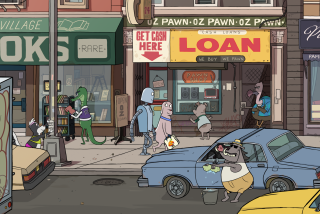GKIDS’ winning pitch as the go-to market for foreign animated films
NEW YORK — “Watch out for the dead bird.”
Eric Beckman, president of GKIDS, is climbing out of his office window to take in the skyline view from a narrow terrace 26 floors above Lower Manhattan. Inside, a staff of seven taps at computers in two rooms crammed with boxes of DVDs, film reels and posters of animated movies from France, Japan and the U.K.
The GKIDS office feels more like an old record store than the headquarters of a company that has helped three movies earn Oscar nominations in as many years. But from this small space, Beckman and his director of distribution, Dave Jesteadt, have found an unlikely foothold as the primary U.S. distributor of sophisticated animated movies produced abroad, such as “The Secret of Kells,” “Chico & Rita” and “A Cat in Paris.”
From Wednesday through Sunday, GKIDS is holding a showcase of its movies at the Laemmle Noho 7 and the AMC 16 in Burbank, including four films that will be qualifying for this year’s Oscar race: “From Up on Poppy Hill,” “The Painting,” “The Rabbi’s Cat” and “Zarafa.”
OSCARS: 71 countries enter foreign language race, but not Iran
Most GKIDS movies would never play in a U.S. theater if the company didn’t exist — they’re too nichey, too weird, too grown-up for American audiences, at least as those audiences are currently served by Hollywood animation studios, which must also fuel theme parks, toy sales and video-game spinoffs.
“Zarafa,” for instance, from French directors Rémi Bezançon and Jean-Christophe Lie, is a hand-drawn film about a friendship between a boy and a giraffe, set against the backdrop of the 19th century slave trade, while “From Up on Poppy Hill,” a movie directed by the son of Japanese animator Hayao Miyazaki, Goro, tells a teenage love story that takes place around the 1964 Tokyo Olympics.
“When everything has to be a four-quadrant, $100-plus-million film, there’s an artistic constriction,” said Beckman. “That’s a huge burden and limits the type of filmmaking that can happen. In live action, you have a range of smaller films. There’s an independent specialty market. We want to be that for animation.”
PHOTOS: Celebrity portraits by the Times
GKIDS’ domestic box office grosses are infinitesimal compared with studio animated movies — so far none of its movies has made more than $1 million at the U.S. box office — but Beckman says all of their films have been profitable for the company, thanks to thrifty marketing and downmarket revenue streams such as DVD and video on demand.
Employing what Jesteadt describes as a “bespoke” style of distribution, GKIDS plans theatrical release campaigns that depend on an enthusiastic embrace from critics and from taste-making members of the animation community.
Because it can’t afford to buy large blocks of TV advertising, GKIDS narrowly targets its audience. For instance, its showcase this week coincides with the CTN Animation Expo, a trade conference that draws artists to Burbank. The company also holds word-of-mouth screenings for its films at the California Institute of the Arts, the school in Valencia that has educated a disproportionate number of the members of the Motion Picture Academy’s animation branch.
“We haven’t needed a $3-million Oscar campaign,” Beckman said. “Animators in L.A. are following what’s happening outside the country. We show them the films and they either win people’s hearts or they don’t.”
Beckman and Jesteadt discovered their niche after a few years of running the New York Int’l Children’s Film Festival, an event they founded in 1997. While scouting films for the festival, they watched international animated titles that delighted audiences, but failed to secure U.S. distribution.
Independently produced animation is far more common in Europe and Japan than the U.S., due to a combination of factors including available government financing, top-tier animation schools and local moviegoing tastes.
PHOTOS: Hollywood backlot moments
In the last decade, the most successful player in the independent animation marketplace in the U.S. has been Sony Pictures Classics, which has found modest audiences for foreign-made animated movies like “The Triplets of Belleville,” “Persepolis” and “Waltz With Bashir.”
There have also been some high-profile homegrown failures in indie animation, such as this summer’s toddler-targeted flop “The Oogieloves in the Big Balloon Adventure” and the 2011 Weinstein Co. sequel “Hoodwinked Too! Hood vs. Evil.”
“Indie animation is notoriously difficult to distribute,” said Sheila Sofian, an independent animated filmmaker and an associate professor at the USC’s School of Cinematic Arts. “There’s hardly any market out there. Most American studios go with more commercial work geared toward children.”
THE ENVELOPE: Awards and Industry Insider
The first film GKIDS licensed and distributed was the Irish-French-Belgian animated movie by Irish illustrator Tomm Moore, “The Secret of Kells,” which garnered an Oscar nomination for animated feature in 2010 and raised GKIDS’ profile.
Its success with Moore’s film helped GKIDS make a pitch to other filmmakers frustrated by the difficulty of breaking into the U.S. market.
“We pitched our movie around the large independents without success,” said Michael Rose, a producer of the animated Spanish romance “Chico & Rita,” “and GKIDS kept saying, ‘Hey guys, give us a chance, we really love this movie.’”
GKIDS picked up the U.S. rights to “Chico & Rita” and helped it secure an Oscar nomination last year, as well as one for the French movie “A Cat in Paris.”
Now the company is expanding — tripling the size of its small office in New York over coming months and releasing more movies with broader ambitions — “From Up on Poppy Hill,” for instance, was the highest grossing movie in Japan last year, and GKIDS is taking the place of the Walt Disney Co. as the U.S. distributor for Miyazaki’s Studio Ghibli.
With further success, GKIDS may get more involved in animation production, Beckman said, advising on scripts and helping filmmakers secure finishing financing. “Going forward we’re gonna be bolder, although not irrational in our releases,” Beckman said. “We’re not looking for the next ‘Shrek.’”
PHOTOS AND MORE
VIDEO: Highlights from the Envelope Screening Series
The Envelope: Awards Insider
PHOTOS: NC-17 movies: Ratings explained
More to Read
Only good movies
Get the Indie Focus newsletter, Mark Olsen's weekly guide to the world of cinema.
You may occasionally receive promotional content from the Los Angeles Times.











